
Almandine Gemstone: Properties, Meanings, Value & Benefits
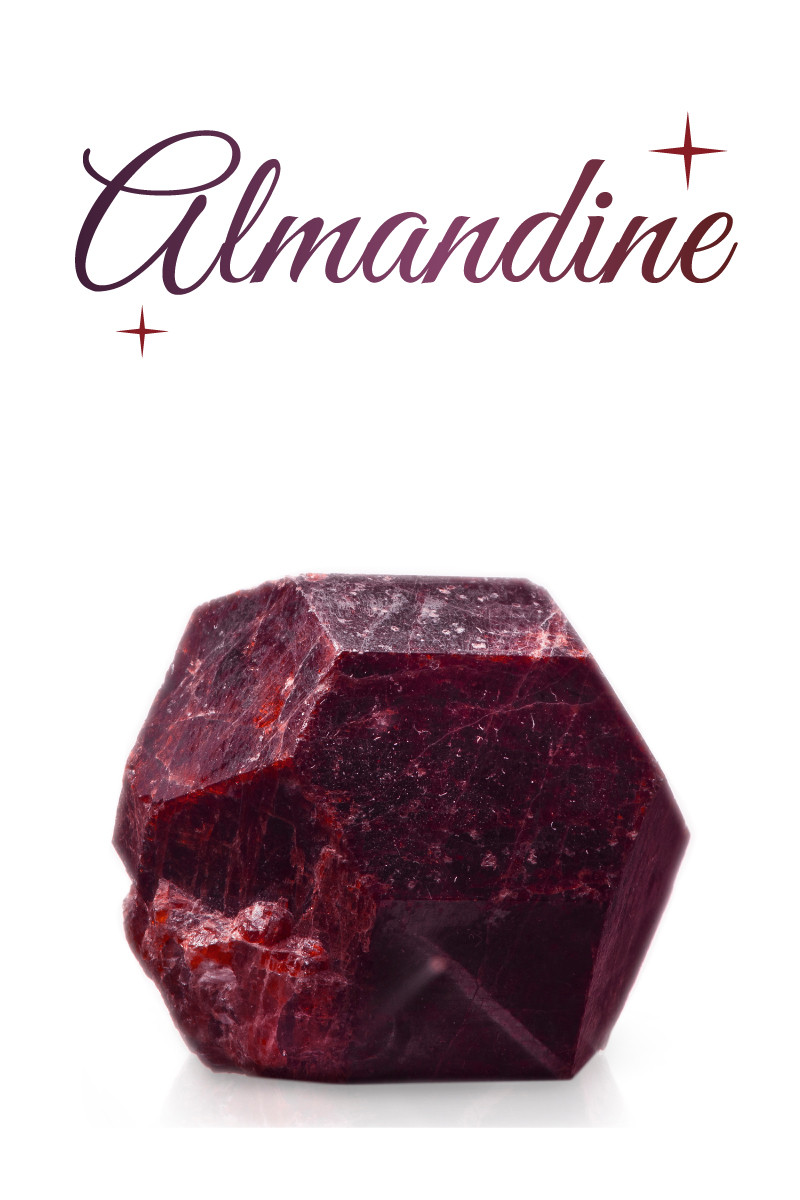 Almandine is a deep red or magenta to brownish-black garnet gemstone variety used and adored since ancient times. It’s arguably the most well-known garnet alongside pyrope.
Almandine is a deep red or magenta to brownish-black garnet gemstone variety used and adored since ancient times. It’s arguably the most well-known garnet alongside pyrope.
Is almandine rare or common? Almandine garnets are very common — the most common garnet variety, in fact. That said, gem-quality almandine crystals make up a small portion of all almandine mined. Since they’re so abundant, though, they make beautiful and affordable gems!
So, what’s the almandine garnet price range? And what makes this gem special? We’ll answer all that and more in this almandine garnet gemstone guide.
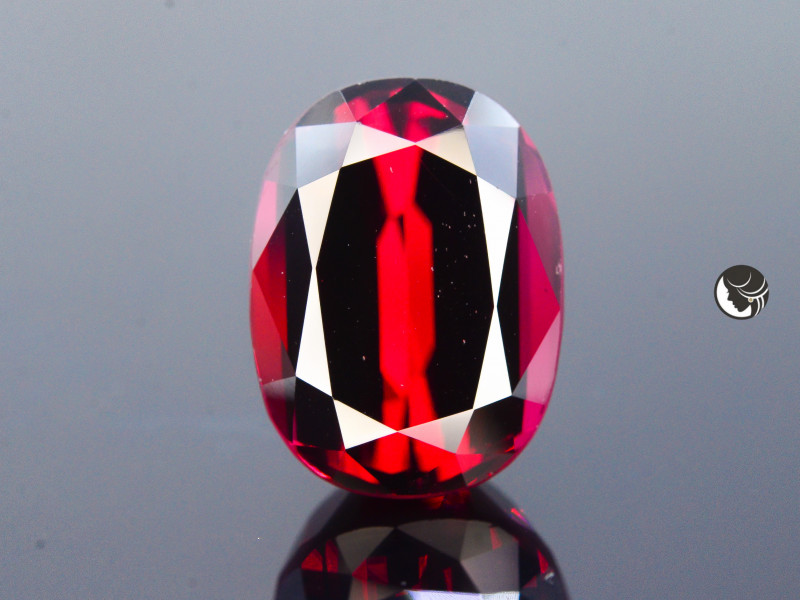
What Is Almandine Garnet?
Almandine garnet is a semi-precious gemstone that serves as the traditional January birthstone. It’s also a lucky zodiac stone for Capricorn and Aquarius and the traditional 2nd wedding anniversary gemstone. If you live in Connecticut, USA, almandine garnet is your official state gemstone!
In the UK, almandine may be called “almandite.” Other alternative names include:
Precious garnet
Oriental garnet
Carbuncle
Almandine ruby
The nickname “carbuncle” has historical relevance we’ll cover more later, but the name “almandine ruby” is a misnomer, as garnets and rubies are separate gems.
Outside of gorgeous gems, almandine also has many industrial uses.
Because of its superior Mohs hardness among garnets, almandine is great for abrasives. These abrasives may be used in sandpaper or replace silica for sandblasting.
Industrial-grade garnets produced for abrasives may be called “rock garnet.” Some unexpected applications for abrasive garnet are woodworking and water filtration.
Additionally, garnets can help geologists study the temperatures and pressures that rocks form under in a field called geothermobarometry. They can similarly indicate geological timelines when used as a geochronometer or thermochronometer.
Almandine Specifications & Characteristics
Almandine is in the pyralspite garnet series along with pyrope and spessartite. The pyralspite group is aluminum-rich, contrasting the calcium-rich ugrandite series — which includes uvarovite, grossular, and andradite.
As an iron aluminum silicate, almandine’s chemical formula is Fe3Al2Si3O12 or Fe3Al2(SiO4)3. To identify almandine, its absorption spectrum is key. Absorption spectrum describes which colors do and don’t pass through when white light is shone into the gem.
With a spectroscope, you’ll see three strong absorption bands in almandines (or almandine-dominant garnets): a strong one that’s 200 Å wide at 5760 and two more strong ones at 5260 and 5050.
Here are all of almandine’s properties:
Mohs hardness: 7-7.5
Color: Deep red, violet-red, reddish-brown, brownish-black, black; Rarely purple or pink; Sometimes black and red
Crystal structure: Isometric/Cubic
Luster: Vitreous, greasy, or resinous - rough; Vitreous to sub-adamantine - polished
Transparency: Transparent to opaque
Refractive index: 1.75-1.83
Density: 3.93-4.30 (star garnet can reach 4.76)
Cleavage: None
Fracture: Conchoidal to uneven
Streak: White
Luminescence: None
Pleochroism: None
Optical effects: Asterism; Very rarely color-change

Types of Almandine
Like most garnets, and pyrope especially, almandine is almost never pure; you’ll usually find it mixed with pyrope or spessartite. Some varieties containing almandine include:
Mozambique Garnet
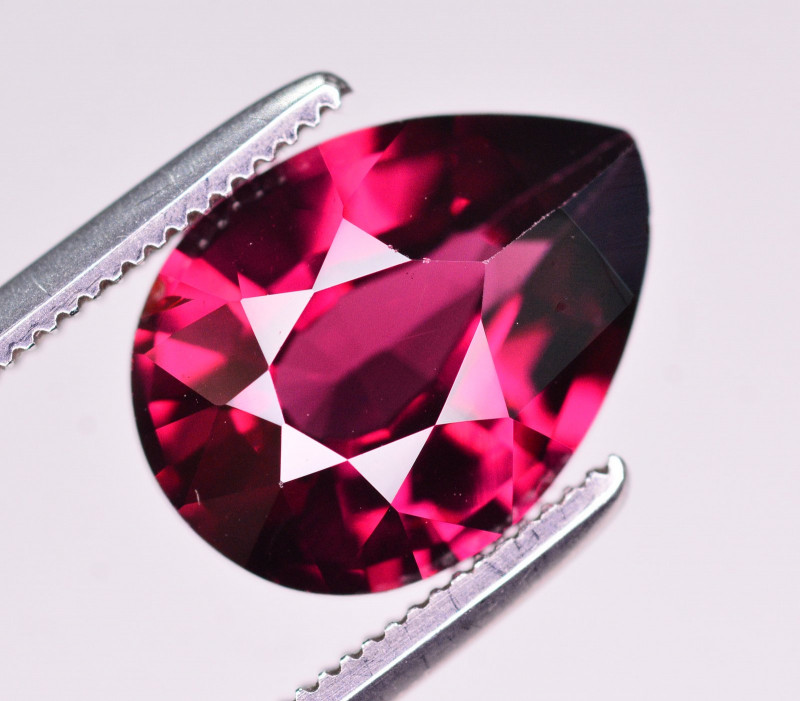
Mozambique garnets are red with brown and orange undertones. Discovered in Mozambique, Africa, these are almandine and pyrope.
Rhodolite
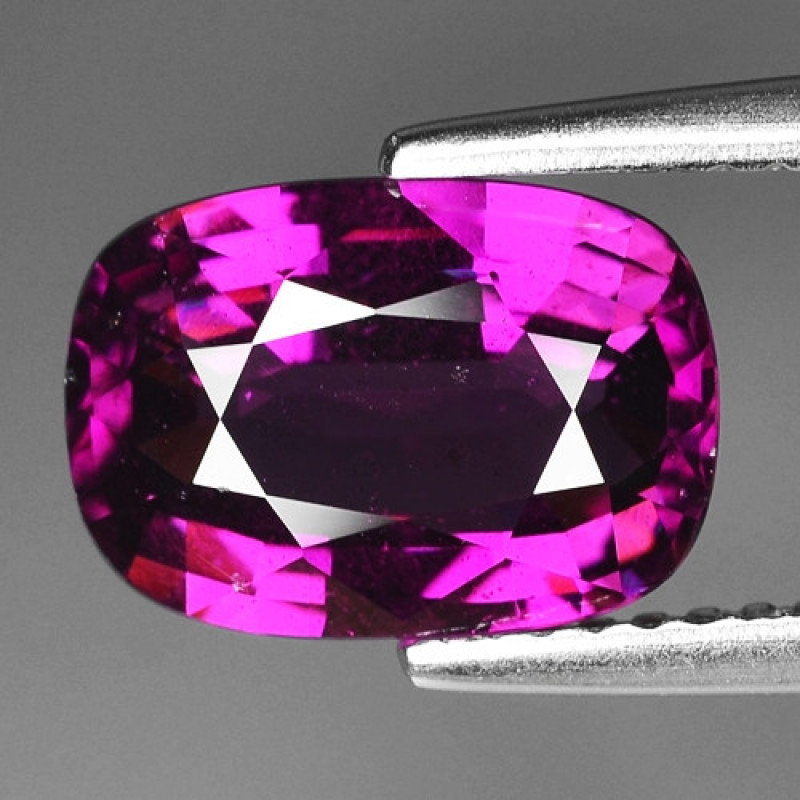
Rhodolite is a commonly purplish-red blend of almandine and pyrope. It can also be pale rose-red, violet, or purple shades. Spessartite added means paler hues. Iron and magnesium impurities create deep purple “grape garnet” rhodolites.
Bright magenta-rose Tanzanian rhodolites with pale pink flashes combine all three pyralspites. These are called “Umbalite garnets.”
The most valuable rhodolites are bright purple, while redder hues are less valuable.
Malaya (Malaia) Garnet
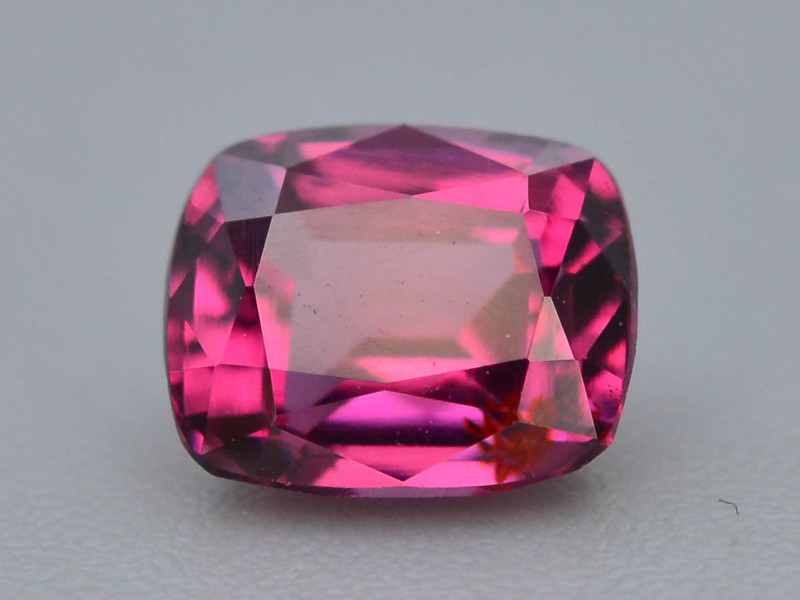
Malaya (or Malaia) garnet is usually a pyrope-spessartite, but it can also contain almandine and grossular garnet. These are pink, salmon, orange, or red.
Color Change Garnet
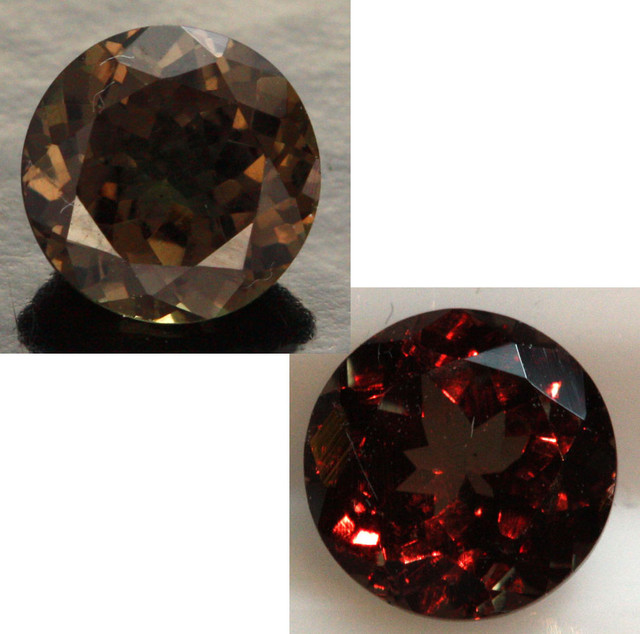
All garnets can be color-changing, though this is rare in almandines. One is the almandine-grossular-spessartite mixture, displaying greenish-yellow or brown hues shifting to purplish-red.
Other color-changing almandines include:
Idaho: Pyrope-almandine, red to purple-red
Norway: Pyrope-almandine, violet-red to blue-green or violet to wine-red
Star Garnet

Star garnets are a rare variety displaying a 4-or 6-rayed light reflection called asterism. These stones are predominantly from Idaho, USA, and serve as the state gemstone.
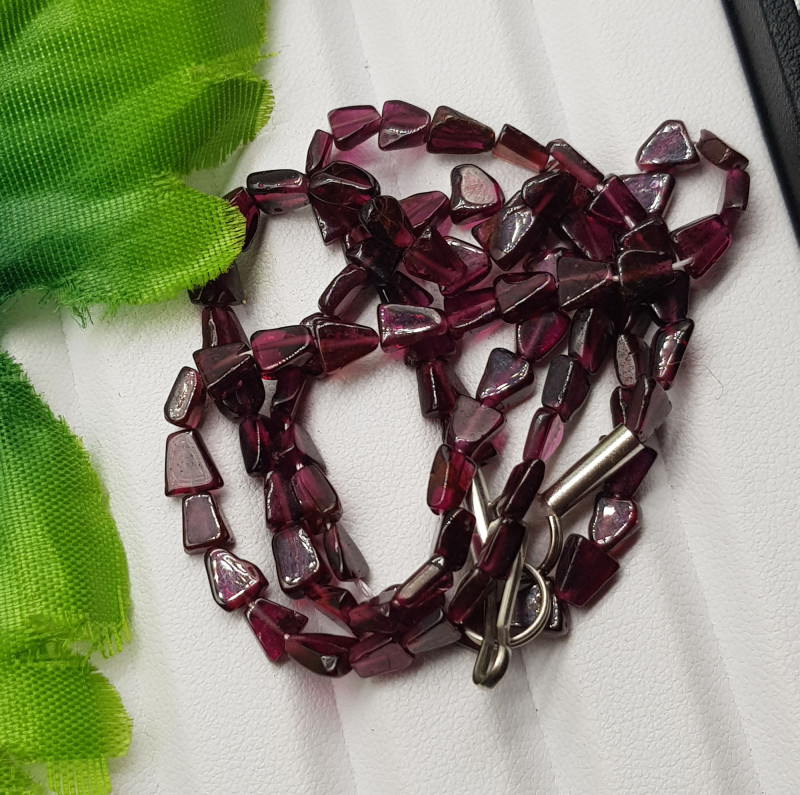
Almandine Meaning & History
The almandine crystal symbolizes deep love, passion, and desire. Individually, the stone also represents courage, achievement, and protection. Persian legends say almandines protect against natural disasters, indicating incoming danger by becoming paler.
Almandine garnets have been known for centuries. The almandine name comes from a mistaken interpretation of alabandicus, given by Roman scholar Pliny the Elder in the 1st century AD. Alabanda was an Asia Minor town where almandines came from.
These cabochons were historically called “carbuncles,” Latin for “live coal” because the darker red stones resembled charcoal on fire. You may see “carbuncle” for vintage jewelry items.
History
The oldest evidence currently available reveals ancient Egyptian uses of almandine dating to 3,500 BC.
Red garnets like almandine sat among the most popular gems during Late Antiquity, from 4th-6th century AD. One popular use was decorative metalwork inlay called cloisonné.
One notable artifact is the Winfarthing pendant, a 7th-century brooch found in Norfolk, England, in 2014. The gold brooch contained hundreds of tiny almandine gems.
Garnet jewelry saw its highest popularity during the Victorian Era, from 1837 to 1901. Before this time, only royalty, nobles, and clergy could afford gems like garnets. The Industrial Revolution made garnets accessible to the masses.
However, wide accessibility lowered garnet’s popularity, as it became less associated with status. Luckily, that also meant more affordable prices!
In 1967, Idaho, USA, named star garnet their state gem. Similarly, Connecticut, USA, named almandine garnet the state’s official gemstone in 1977.

Almandine Healing Properties
Like all gems, almandine’s color influences its power as a healing stone. Typical red hues evoke the passion, drive, and energy of red gemstones.
Meanwhile, brown hues are great for grounding, especially when used as chakra stones for opening the root chakra — bringing strength and connection!
Stronger purple coloring in almandine brings the purple gemstone benefits of spiritual awakening and wisdom.
Physical Healing
Purported physical benefits of almandine include increasing:
Strength & endurance
Fertility & libido
Blood circulation
Iron absorption
Immune system function
Emotional Healing
Emotional almandine garnet benefits are said to boost feelings of:
Connection
Resilience
Stability
Motivation
Apart from its healing powers, is almandine garnet valuable? It depends on its properties.
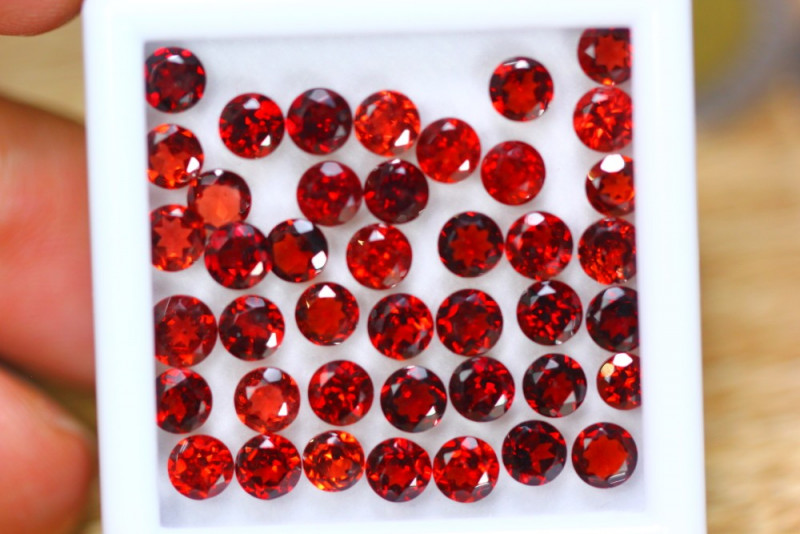
Almandine Gemstone Properties
Almandine is graded based on the standard categories of color, cut, clarity, carat weight, and treatments.
Color
The color of almandine ranges from classic deep reds and purplish-reds to brownish hues. The iron content is responsible for some of the coloring, but that iron can also be substituted by manganese (from spessartite) and magnesium, leading to opaque, browner stones.
Classic red hues are generally most valuable, particularly in large, transparent stones as larger sizes are usually too dark. Rhodolite and Malaya garnets with good coloring have the highest prices.
Cut
Most faceted garnets are almandine, and the shapes are endless. Carvings are less common, but many historical or designer almandine carvings are valuable. Almandines may also be cut as beads.
Though cabochons (often called “carbuncles”) are slightly less common, the star garnet variety must be cut en cabochon to display its asterism. These can be quite valuable, as star garnets are notoriously tricky to cut correctly.
Clarity
Clarity describes the extent of visible inclusions in a stone. Almandines usually have a Type I colored gemstone clarity grade, meaning little to no eye-visible inclusions. Pyrope-almandine mixtures may be Type II, with some visible inclusions.
That said, some possible inclusions in almandine stones are:
Needles (hornblende, rutile, augite)
Crystals (e.g. spinel, biotite, apatite, quartz, ilmenite, monazite) that may appear speckled, irregular, or knobby
Dense rods (hornblende)
Crystals with “halos” from natural irradiation (zircon), most from Sri Lanka
While these inclusions generally lower value, certain fibrous inclusions of amphibole or pyroxene minerals that cause asterism increase value.
Carat Weight
Almandine crystals vary in size, but smaller crystals show better coloring. When formed in a matrix that becomes weathered, it can separate into well-formed, often large crystals. That said, broken crystals from some locales may only yield gems under 2 carats.
Most almandine gems won’t significantly change in price-per-carat based on their size.
The exceptions are rhodolite — which increases in rate based on whether it’s under 1 carat, under 10 carats, or over 10 carats — and Malaya — which increases in rate for under 1 carat, under 5 carats, and over 5 carats.
Currently, the largest almandine is 174 carats!
Treatments & Synthetics
While uncommon, some almandines may be treated. Usually, almandine-spessartite or pyrope-almandine garnets are heated to create a metallic coating, sometimes of hematite. The latter were historically called “Proteus garnets.”
The majority of synthetic almandines (which are less valuable) are created through hydrothermal growth. You can identify these based on the presence of seed plates.

Almandine Formation & Sources
Like most garnets, almandine usually forms when aluminum-rich, sedimentary rocks undergo metamorphic changes from pressure and heat. These conditions alter the minerals inside into garnet.
You’ll find almandine in metamorphic rocks like mica-rich garnet schists, where it may form in a matrix with the rock. They’re also found in alluvial deposits and igneous rocks.
Mining Locations
New York, USA contains the world’s largest garnet mine, producing roughly 90 percent of the world’s industrial garnet. Industrial “rock garnet” also comes from China and India.
For gem-quality almandine, India and Brazil are top producers. Other sources include:
Afghanistan
Austria
Canada
Czechia
Ethiopia
Greenland
Japan
Kenya
Myanmar
Norway
Pakistan
Russia
Solomon Islands
Sweden
Tanzania
Uruguay
USA (Alaska, Colorado, Connecticut, Maine, Michigan, Pennsylvania, South Dakota)
Vietnam
Zambia
The main almandine variety sources are:
Malaya: Kenya, Madagascar, Tanzania
Rhodolite: Brazil, India, North Carolina (USA), Sri Lanka, Tanzania, Thailand
Mozambique: Mozambique (shocker)
Large almandines are known from Madagascar and Sri Lanka.

Almandine Price & Value
Because almandine is the most common garnet, most are affordable. The only exceptions are the rare rhodolite and Malaya garnets.
First, let’s look at almandine garnet price-per-carat ranges that don’t change by size. “Top color” almandines refer to those with moderately strong saturation, medium-dark tone, and these colors: orange-red, red, purplish-red, reddish-purple.
Top Color: $1-$30 per carat
Mozambique: $5-$35 per carat
Red to purple almandine cabochons are also $1-$20 per carat, regardless of size.
The faceted gem prices by size for rhodolite are:
0.5 to 1 carat: $20-$100 per carat
1 to 10 carats: $20-$150 per carat
Over 10 carats: $150-$300 per carat
Now, the faceted prices for Malaya garnets:
0.5 to 1 carat: $30-$60 per carat
1 to 5 carats: $150-$200 per carat
Over 5 carats: $300-$3,000 per carat
Mozambique garnet cabochons are always $5-$7 per carat. The ranges for rhodolite cabochons are $4-$6 per carat under 1 ct, $5-$30 per carat when 1-10 cts, and up to $40 per carat when over 10 cts.
Almandine carvings are also pricier, starting at $450 and reaching $84,500.
Gem-quality raw almandine crystals are generally $0.02-$0.08 per carat.
Almandine Care and Maintenance
Luckily, gemstone care for almandine is easy! No cleavage and good hardness makes this stone durable enough for daily wear. You may opt for protective settings in a more vulnerable almandine garnet ring to prevent scratches, though.
You can clean almandine gently with mild soap, warm water, and a soft toothbrush. Don’t use mechanical or steam cleaners.
Almandines with inclusions are more sensitive to extreme heat. Store the gem in a cool, dry place away from other stones.
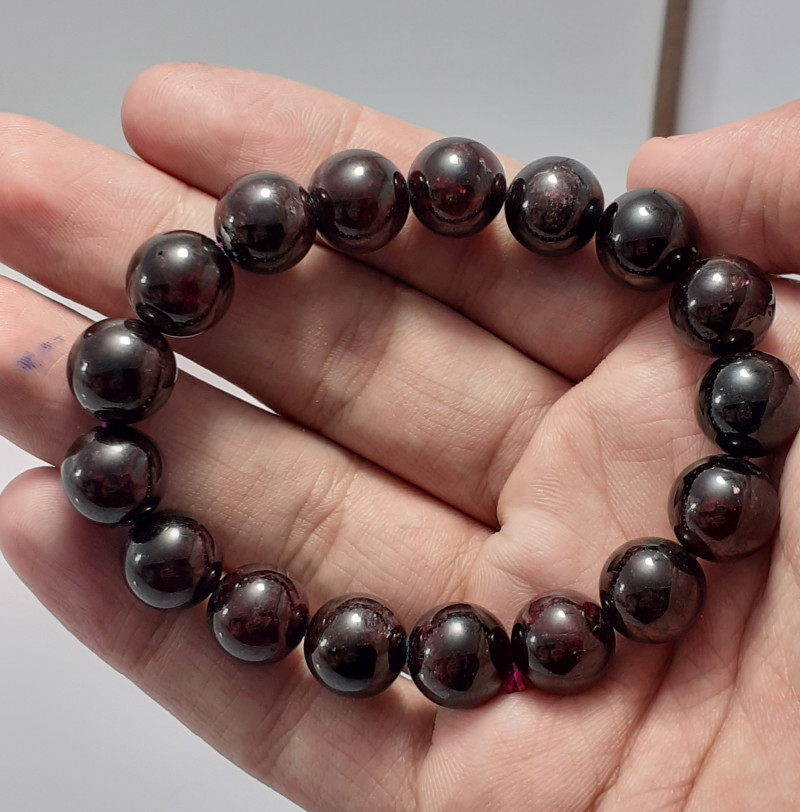
Discover Deeper Love with Almandine!
Almandine is perfect for love in every form — attracting romance, strengthening friendship, and encouraging self-love. With a gorgeous and affordable gem like almandine, you’re set for joy, passion, and love!
Search the Gemstone Encyclopedia
Related Auctions
Related Articles
Originally the Birthstones or gemstones were associated with a zodiac sign or the month of a individuals birth. Find out what your stone is and view the stones we have for sale
8th Feb 2021
There are dozens of quartz and chalcedony gems with various colors and patterns. Learn all about quartz properties and every type of quartz, from amethyst and agate to plasma and phantom quartz!
15th Oct 2020
Hackmanite is a pink to violet sodalite gem known for its unique color-change and luminescence. Learn why hackmanite is special, from its rare qualities to the types of hackmanite jewelry available.
28th Mar 2018
Latest Articles
Catapleiite is a lesser-known mineral and rare gemstone often found as stunning tabular rosettes near other rare stones. Discover the history, prices, benefits, and properties of catapleiite!
28th Apr 2025
Yugawaralite is a rare colorless, white, or pinkish zeolite crystal named for its discovery in Yugawara, Japan. Here we uncover the multifaceted history, properties, prices, and uses of yugawaralite.
24th Mar 2025
Simpsonite is a lesser-known mineral known on the gem market for its durability, yellow-orange color, and rarity. Discover all the properties, uses, prices, and history of simpsonite.
3rd Mar 2025
Article Categories
How To's is where you will find helpful articles from gem Rock Auctions on how to cut gemstones, select gemstones and buy gemstones.
9 Articles







